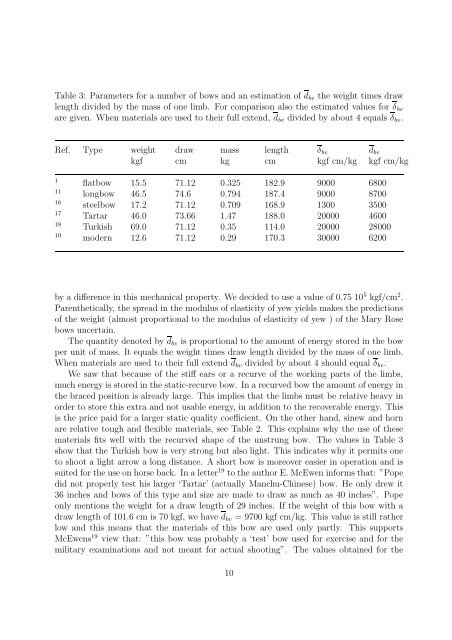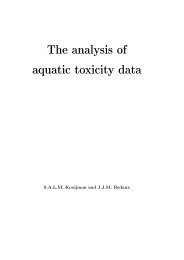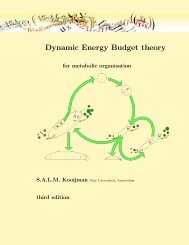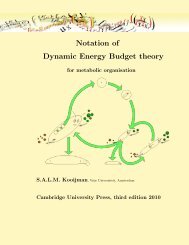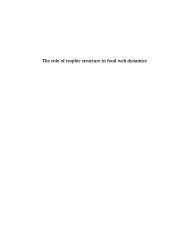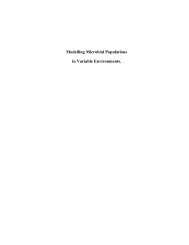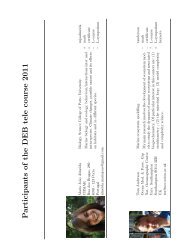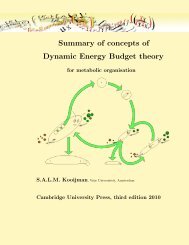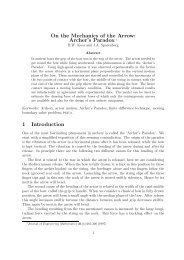Archery and Mathematical Modelling 1
Archery and Mathematical Modelling 1
Archery and Mathematical Modelling 1
You also want an ePaper? Increase the reach of your titles
YUMPU automatically turns print PDFs into web optimized ePapers that Google loves.
Table 3: Parameters for a number of bows <strong>and</strong> an estimation of d bv the weight times drawlength divided by the mass of one limb. For comparison also the estimated values for δ bvare given. When materials are used to their full extend, d bv divided by about 4 equals δ bv .Ref. Type weight draw mass length δ bv d bvkgf cm kg cm kgf cm/kg kgf cm/kg1flatbow 15.5 71.12 0.325 182.9 9000 680011longbow 46.5 74.6 0.794 187.4 9000 870016steelbow 17.2 71.12 0.709 168.9 1300 350017Tartar 46.0 73.66 1.47 188.0 20000 460018Turkish 69.0 71.12 0.35 114.0 20000 2800010modern 12.6 71.12 0.29 170.3 30000 6200by a difference in this mechanical property. We decided to use a value of 0.75 10 5 kgf/cm 2 .Parenthetically, the spread in the modulus of elasticity of yew yields makes the predictionsof the weight (almost proportional to the modulus of elasticity of yew ) of the Mary Rosebows uncertain.The quantity denoted by d bv is proportional to the amount of energy stored in the bowper unit of mass. It equals the weight times draw length divided by the mass of one limb.When materials are used to their full extend d bv divided by about 4 should equal δ bv .We saw that because of the stiff ears or a recurve of the working parts of the limbs,much energy is stored in the static-recurve bow. In a recurved bow the amount of energy inthe braced position is already large. This implies that the limbs must be relative heavy inorder to store this extra <strong>and</strong> not usable energy, in addition to the recoverable energy. Thisis the price paid for a larger static quality coefficient. On the other h<strong>and</strong>, sinew <strong>and</strong> hornare relative tough <strong>and</strong> flexible materials, see Table 2. This explains why the use of thesematerials fits well with the recurved shape of the unstrung bow. The values in Table 3show that the Turkish bow is very strong but also light. This indicates why it permits oneto shoot a light arrow a long distance. A short bow is moreover easier in operation <strong>and</strong> issuited for the use on horse back. In a letter 19 to the author E. McEwen informs that: ”Popedid not properly test his larger ‘Tartar’ (actually Manchu-Chinese) bow. He only drew it36 inches <strong>and</strong> bows of this type <strong>and</strong> size are made to draw as much as 40 inches”. Popeonly mentions the weight for a draw length of 29 inches. If the weight of this bow with adraw length of 101.6 cm is 70 kgf, we have d bv = 9700 kgf cm/kg. This value is still ratherlow <strong>and</strong> this means that the materials of this bow are used only partly. This supportsMcEwens 19 view that: ”this bow was probably a ‘test’ bow used for exercise <strong>and</strong> for themilitary examinations <strong>and</strong> not meant for actual shooting”. The values obtained for the10


